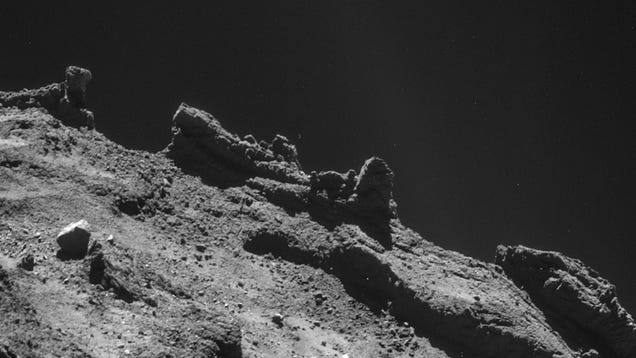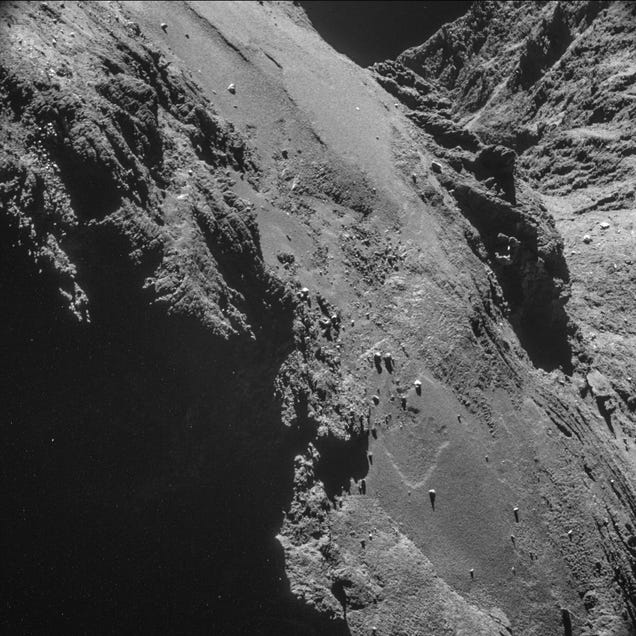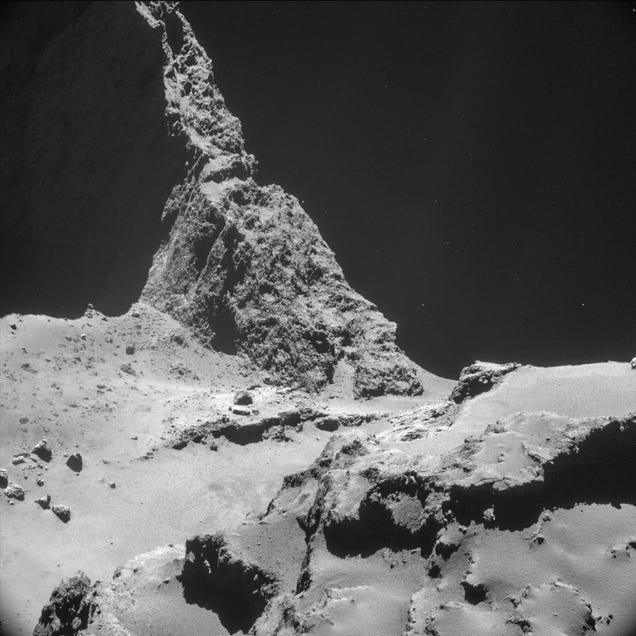DA_Champion
Avenger
- Joined
- Aug 26, 2013
- Messages
- 11,483
- Reaction score
- 708
- Points
- 73
- delete -
Last edited:
I get the feeling we'll be seeing a few more stories like this...
Nicaragua Hit by Meteor as Major Asteroid Narrowly Misses Earth
http://mashable.com/2014/09/07/nicaragua-meteor-strike/

Meteorite that hit Nicaragua 'dropped off' larger asteroid
http://www.bbc.com/news/science-environment-29106439
Is the Universe a 2D Hologram? Experiment Aims to Find Out
http://www.livescience.com/47600-universe-2d-hologram-holometer-experiment.html
Very misleading to put up an illustration of an Alcubierre warp ship with the title referencing an impossible space engine.
Total Lunar Eclipse On Wednesday Will Be a Rare 'Selenelion'
Observers of Wednesday morning's total lunar eclipse might be able to catch sight of an extremely rare cosmic sight.
On Oct. 8, Interested skywatchers should attempt to see the total eclipse of the moon and the rising sun simultaneously. The little-used name for this effect is called a "selenelion," a phenomenon that celestial geometry says cannot happen.
And indeed, during a lunar eclipse, the sun and moon are exactly 180 degrees apart in the sky. In a perfect alignment like this (called a "syzygy"), such an observation would seem impossible. But thanks to Earth's atmosphere, the images of both the sun and moon are apparently lifted above the horizon by atmospheric refraction. This allows people on Earth to see the sun for several extra minutes before it actually has risen and the moon for several extra minutes after it has actually set. [How to See the Total Lunar Eclipse (Visibility Maps)]
As a consequence of this atmospheric trick, for many localities east of the Mississippi River, watchers will have a chance to observe this unusual sight firsthand. Weather permitting, you could have a short window of roughly 2 to 9 minutes (depending on your location) with the possibility of simultaneously seeing the sun rising in the east while the eclipsed full moon is setting in the west.
See Uranus with a Shadowy Full Moon During Total Lunar Eclipse
Most of North America will witness a total eclipse of the moon Wednesday (Oct. 8), but the morning sky, weather permitting, will also hold a surprise for intrepid skywatchers interested in seeing another celestial body alongside the eclipsed moon.
The planet Uranus will be in opposition to the sun on Tuesday evening, placing it very close to the full moon during the total lunar eclipse on Wednesday morning. Uranus is just around the limit of naked-eye visibility at magnitude 5.7, so interested observers will need binoculars to spot it. Even in the most powerful telescopes, Uranus is so far away that it will be only a tiny, featureless, blue-green disk.
The lunar eclipse officially begins when the moon slips into the faint outermost shadow of the Earth, called the penumbra. This shading, which occurs at 4:15 a.m. EDT (0815 GMT) on Wednesday, is so subtle that it might be invisible to the casual observer. [How to See the Total Lunar Eclipse (Visibility Maps)]
An hour later, at 5:15 a.m. EDT, the moon enters the Earth's darker inner shadow, or umbra. At that point, the shading will be quite obvious. By 6:25, the moon will be totally within the umbra, where it will remain until 7:24 a.m. EDT. At 8:34 a.m. EDT, Earth's satellite will be out of the umbra, and by 9:34 a.m. EDT, the eclipse will be over.
The only catch is that the Earth will continue rotating throughout the lunar eclipse, which will cause the moon to set in many locations before the eclipse is over. Because of this rotation, stargazers in the eastern parts of North America could miss some or all of the later parts of the eclipse.
For example, observers in New York City will see the moon set at 7:04 a.m. EDT, while the moon is still fully eclipsed. But in Los Angeles, the moon sets at 7:05 a.m. PDT, so skywatchers there will see the entire eclipse.
An eclipse of the moon is totally safe to view with the naked eye, binoculars or a telescope. In fact, the best views of a total eclipse can be with the naked eye or low magnification on binoculars.
Lunar eclipses are relatively easy to photograph, though skywatchters should use a telephoto lens to emulate the optical illusion whereby the moon appears much larger to the eye than it does to a camera. Be sure to remove any filters to avoid ghost images. (I once ruined a beautiful series of eclipse photos by leaving a filter in place, and got two moons in every shot.)
Photographing Uranus alongside the eclipsed moon will be a challenge because, even in full eclipse, the moon is still a very bright object, and will probably swamp Uranus' faint light.
Astronomers can't predict how dark the moon will be or what color the natural satellite will appear during the eclipse. The color and brightness of the moon during a total eclipse depend on weather conditions all around the world in the path the sun's light follows on its way past the Earth. Because of this, astronomers don't usually refer to a lunar eclipse as a "blood moon." Sometimes, the moon is tinted strongly red during an eclipse, but just as often it is yellow, copper or grey. Skywatchers will only find out for sure next Wednesday morning.
Editor's Note: If you snap an amazing picture of the Oct. 8 total lunar eclipse, you can send photos, comments, and your name and location to managing editor Tariq Malik at [email protected].
This article was provided to Space.com by Simulation Curriculum, the leader in space science curriculum solutions and the makers of Starry Night and SkySafari. Follow Starry Night on Twitter @StarryNightEdu. Follow us @Spacedotcom, Facebook and Google+. Original article on Space.com.
what is the poll asking about?
Probably the first post in the thread.
http://forums.superherohype.com/showpost.php?p=11003199&postcount=1

LoL.....really? Ripping through Uranus! LMAO! No pun intended.

In the weeks prior to the Philae landing, the Rosetta spacecraft maintained an orbit around Comet 67P/CG at less than six miles from its surface. The ESA has just released a collection of previously unpublished images taken by Rosetta's navigation camera, revealing the varied and dramatic terrain of a mysterious world.
Boulders seem to defy gravity in the view below, apparently clinging to the steep sides of the larger lobe of the comet — although, of course, it is all a matter of the orientation of the image and the local gravity vector. But perhaps the most intriguing feature in this frame is on the right-hand side, where thin layers of rock have the appearance of being flexed or compressed. This feature sits close to the "neck" of the comet, which can be seen in the background rising up towards the smaller of the comet's two "lobes."
One theory for the comet's formation is that two smaller bodies collided to create the comet shape we see today. Whether this layered feature is due to such a scenario or a completely different process remains to be seen.

This scene features the boulder named Cheops, the largest and brightest boulder towards the top left of the image. It measures about 147 feet across and 82 feet high. Cheops and the surrounding cluster of boulders reminded scientists of the famous pyramids at Giza near Cairo in Egypt, and so it was named for the largest of those pyramids, the Great Pyramid, which was built as a tomb for the pharaoh Cheops around 2550 BC.

This view focuses on the boulder-strewn neck region of the comet, with the smaller lobe on the left and the larger lobe on the right. The scene also shows the contrast between the rugged material in the cliff walls rising up to the smaller lobe and the soft, more "textured" material that characterizes the neck and that is also coating the larger lobe in this region.

This dramatic view along the horizon highlights several relatively smooth, flat-topped plateaus that stand above the rugged surface on the larger lobe of the comet. But their flat tops betray the scars of the walls just below, extensively crisscrossed with fracture-like features. At their bases lies plentiful rubble, perhaps once originating from the cliff faces, having crumbled away under the erosive forces at work on the comet.

Seeing this image, I can't help but notice its similarity to how earlier space artists, such as the famed Chester Bonestell, imagined the lunar surface would look like:

They need to rename that poor freaking planet.
They need to rename that poor freaking planet.
A shame the Rosetta Mission may be cut short due to probe battery life. They're apparently drilling the comet as we speak.
They need to teach people how to pronounce it. 'yu-rin-is'
Or at least teach people to pronounce it correctly - Your eh ness.
They need to teach people how to pronounce it. 'yu-rin-is'
* Scientists confirmed Philae sent back all of its sensor data before batteries finally died
* Used drill to turn it 35 degrees and move solar panels into a better position to try and charge batteries
* ESA still trying to locate the lander on the surface of the comet using high-res images from Rosetta
* Have spotted images of its first landing site - but not its second or third after it bounced on the surface
* The probe is thought to be partially on its side under a cliff, and its main solar panels are shrouded in darkness
* Spectrometer onboard failed - and lens cap did not come off
* Earlier today scientists told the probe to use its tenth and final instrument - the drill - to collect samples
* Nonetheless, scientists said they have done 80 to 90% of the primary science and heralded the mission a success
* Philae made three historic touchdowns on 67P on Wednesday, making it the first craft to land on a comet
I know I shouldn't be but I'm weirdly emotional about Philae. I know the trip was mostly a success but the idea of it snoozing on a comet for ever is a little sad

